The Library of Spanking Fiction: Wellred Weekly
|
||||||
|
Articles
Items of interest regarding all things spanking
|
||||||
|
|
The Birch and its Domestic Use with illustrations by Louis Malteste sourced by Februs 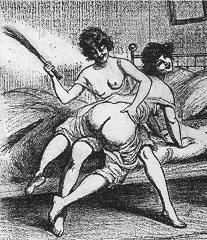 The birch has a long history as an implement of punishment. It times past, before the so-called Age of Reason in the late 17th century, the boundaries between home and the workplace were blurred and so too were the relationships and boundaries of the family. The birch has a long history as an implement of punishment. It times past, before the so-called Age of Reason in the late 17th century, the boundaries between home and the workplace were blurred and so too were the relationships and boundaries of the family.Even into the 20th century in England, employees were sometimes described in legal parlance as servants, with the pater familias being head of the household with all the responsibilities and duties that entailed; including the corporal punishment of his dependants. Indeed, as late as the 1950s, a charge of assault, which was brought against an employer who spanked his 19-year-old au pair, was thrown out on just such grounds. By then of course the birch, which surely would have dismayed the court, had fallen from favour everywhere but HM Prisons and the Isle of Man. In earlier times it would have been different of course, right up to the First World War in fact, the birch had its place in many respectable homes. But before we focus on its domestic use in Britain between the Restoration and the Edwardian Age, let us look at what we mean by the birch. 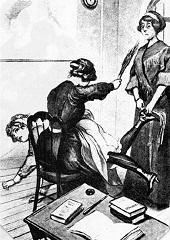 The birch is named for the species of tree in the Betula family, which historically is most often used to make birchen rods for correction. Although not unknown in North America, the Betula Pubescens is most associated with the British Isles, Scandinavia and Northern Europe where it is still used in the sauna. However, other species of tree and shrub such as hazel, beech or willow can be used to make a 'birch rod,' so long as the withes (or twigs) are thin and supple. The birch is named for the species of tree in the Betula family, which historically is most often used to make birchen rods for correction. Although not unknown in North America, the Betula Pubescens is most associated with the British Isles, Scandinavia and Northern Europe where it is still used in the sauna. However, other species of tree and shrub such as hazel, beech or willow can be used to make a 'birch rod,' so long as the withes (or twigs) are thin and supple.The Nordic and Germanic peoples, who probably introduced the birch rod into Britain, usually contend that a birch rod must be 'green,' that is freshly cut before being put to use. Whilst this is undoubtedly true, the tradition in England was often to steep the rods in strong brine and vinegar for storage so as to be ready for use. This was largely because even by the 18th century England was largely urbanised and fresh birch twigs were not be had, especially in London where much of the well-to-do resided for most of the year. The effectiveness of a birch rod for punishment is determined by the length and weight of the withes. The judicial birch, often known as a senior birch, was between four and sometimes six feet long and weighed at least one pound (450g), and consisted of up to 16 lengths. It was last used officially in England in 1960 and the Isle of Man in 1976. 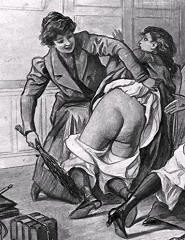 In the domestic arena there were two grades of lesser birch. Young women and maids were supposed to be dealt with by means of a standard or governess birch. The sometimes rather fanciful Englishwoman's Domestic Magazine suggested that a governess birch should be a minimum of three feet long, with six to nine withes and weigh no less than six ounces for application to the bared bottom of a 16-year-old girl. With three inches and approximately two ounces added for each year of growth, "saving that the rod should not greatly exceed 42 inches" in length or 10 ounces in weight. In the domestic arena there were two grades of lesser birch. Young women and maids were supposed to be dealt with by means of a standard or governess birch. The sometimes rather fanciful Englishwoman's Domestic Magazine suggested that a governess birch should be a minimum of three feet long, with six to nine withes and weigh no less than six ounces for application to the bared bottom of a 16-year-old girl. With three inches and approximately two ounces added for each year of growth, "saving that the rod should not greatly exceed 42 inches" in length or 10 ounces in weight.The lesser or nursery birch was designed with children in mind and was supposed to be at least half the weight of a governess birch and considerably shorter. Although several readers to the Englishwoman's Domestic Magazine protested at the severity of using such harsh measures and one mother asked "what is wrong with a slipper?" Indeed, as is illustrated in the top picture, most mothers preferred the nursery birch even for their adult daughters, given the severity of the alternative. 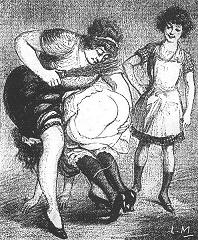 One of the reasons the birch went out of fashion however, is that it required the young lady to bare her bottom for chastisement and by the late Victorian Age, this seemed altogether too lewd. One of the reasons the birch went out of fashion however, is that it required the young lady to bare her bottom for chastisement and by the late Victorian Age, this seemed altogether too lewd.However this reluctance was not always the vogue. Often the humiliation of exposure was considered a vital part of the punishment. It is said that in Norfolk up until the 1930s it was the custom to send girls into the fields 'dressed only in their shifts' (blouses or shirts) to cut lengths of hazel 'for the necessary.' In the movie Lady Jane, the gentlemen are sent from the room while Helena Bonham-Carter gets her thrashing. But in actual fact in real life it was her father who birched the future Queen Jane. Indeed it seems that before the second half of the Victorian Era, the bare bottom correction of women before or by men was considered a necessary evil. 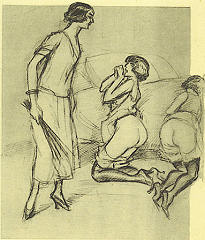 In the 1790s one lady wrote to her former guardian saying: "...you were such a beast. I was so often most dreadfully birched by you right there in parlour. I remember those times when you forced me face down on the divan with my skirts up around my ears for all to see after some mischief or other. Oh how I did rue the birch in those days, but I expect I deserved it. Oh happy days." In the 1790s one lady wrote to her former guardian saying: "...you were such a beast. I was so often most dreadfully birched by you right there in parlour. I remember those times when you forced me face down on the divan with my skirts up around my ears for all to see after some mischief or other. Oh how I did rue the birch in those days, but I expect I deserved it. Oh happy days."A hundred or so years later in a 'better home' a governess might have been more careful of her charge's dignity. One governess handbook suggested "for the older girl who thinks herself a woman, a public scolding then an open announcement of the chastisement to follow may be quite beneficial in bringing a spirited girl down a peg or two. However, one should on no account thrash an older girl before others. Better to send her to her room to await the rod." However once alone with her charge she was advised "not to stint with the rod, but ply it vigorously to her unprotected behind with as many strokes as it takes to bring her to her senses." 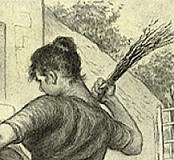 A contributor to the Englishwoman's Domestic Magazine took issue with this. She suggested that a birching should be "as prolonged, painful and humiliating as possible." A contributor to the Englishwoman's Domestic Magazine took issue with this. She suggested that a birching should be "as prolonged, painful and humiliating as possible."There is much anecdotal evidence from prisons and orphanages where the birch was much in use until the middle of the last century. This suggests that as a punishment the birch was much feared and recipients might expect not to be able to sit down for some days after its administration. The memoirs of one orphan girl who had the dubious pleasure of sojourn in an establishment for the orphaned daughters of gentlefolk reported: "At supper you could always tell the girls who had been up before the Directress as they were allowed, and no doubt preferred, to stand behind their chairs at table." 13 comments
|
|||||
| Pages: 1 2 3 4 5 6 7 8 9 10 11 12 13 14 15 16 17 18 19 | ||||||


